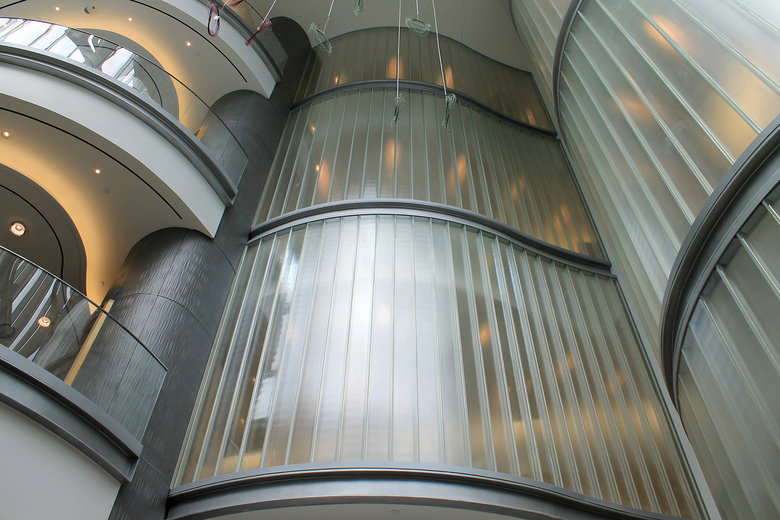Bendheim Glass Inside KPF's New Science Campus
John Hill
17. 十月 2014
Photo: Courtesy of Bendheim
Two side-by-side buildings – the CUNY Advanced Science & Research Center and the City College Center for Discovery & Innovation – recently opened on City College's Harlem campus. Bendheim's channel and dichroic glass defines much of the interiors.
KPF's design – carried out with architect of record Flad Architects – treats the two buildings, which together create a new City University of New York (CUNY) science campus in upper Manhattan, as a gateway to the campus of City College, one of the two-dozen institutions that make up the CUNY system. Connected by a base with a plaza on top, the two buildings face each other with curving glass walls, as if formed by moving water.
Exterior of two buildings. Photo: Jeremy Bitterman, courtesy of KPF
The curves of the exterior walls are echoed inside each building, where curved walls of Bendheim's channel glass exceeding 14 feet in height (4.25 meters) overlook the atrium spaces behind the glass façades. According to KPF director Hana Kassem, the glass helps to "create a sense of fluidity and ribbon-like continuity that we used to define the interior public and social spaces as if we carved away through the buildings ... beginning at the entrances and reaching in a spiraling, upward fashion towards the light of the central vertical spaces in both buildings."
Photo: Courtesy of Bendheim
Photo: Courtesy of Bendheim
KPF selected two types of channel glass: Solar and Clarissimo, the former offering "veiled images for a soft sense of privacy," per Bendheim, and the latter more transparent for vision areas. Further, the Center for Discovery & Innovation uses a low-iron channel glass, while the ASRC opts for the standard Lamberts channel glass with ~60% recycled content. The difference is one of color, as the low-iron glass appears white, while the standard glass is greenish.
Photo: Courtesy of Bendheim
The stairs, their straight and curved edges wrapped by the channel glass at certain levels, benefit from the introduction of the dichroic glass, specifically Bendheim's Optichroic® SatinTech glass for the guardrails. The 3/4" laminated safety glass in both straight and curved applications gives the client their desired "color without color," since the dichroic glass's color shifts depending on the angle of light and one's angle of view. Kassem appropriately relates the material choice to the work being carried out within the buildings: "[Aiming for] a sense of wonder that could be associated with scientific experimentation conducted in the labs ... the constantly shifting and changing hues point to the explorations of physics and optics with subtlety."
Photo: Courtesy of Bendheim
相关文章
-
Bendheim Glass Inside KPF's New Science Campus
on 2014/10/17






